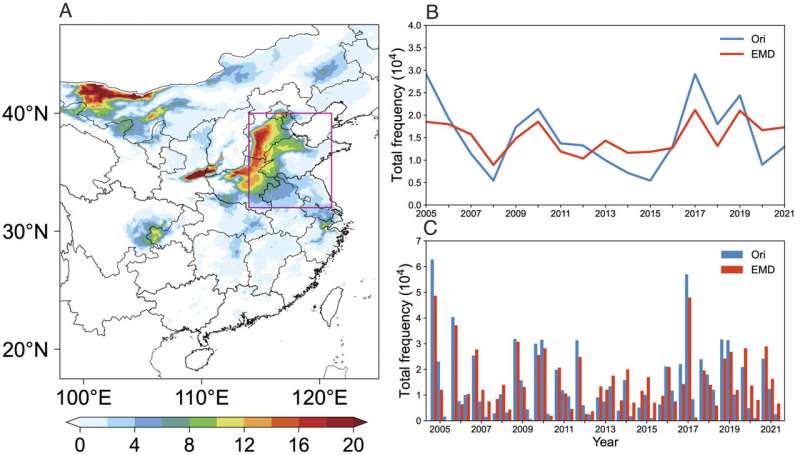This article has been reviewed according to Science X's editorial process and policies. Editors have highlighted the following attributes while ensuring the content's credibility:
fact-checked
peer-reviewed publication
trusted source
proofread
Researchers construct model to predict frequency of heat wave and air pollution co-occurrence in China

Researchers led by Hong Kong Baptist University (HKBU) have developed a statistical model that uses patterns of springtime warming in the western Pacific Ocean, western Indian Ocean and Ross Sea to predict the frequency of summertime co-occurrence of heat waves and air pollution in China.
The model provides useful information for the government authorities and the general public to take advance actions to mitigate damage from the joint hazards. The research findings have been published in the Proceedings of the National Academy of Sciences (PNAS).
Heat wave and air pollution co-occurrence becomes more frequent
The issue of global warming attracted grave attention again recently as the world registered its hottest day to date for the third time in the first week of July this year, with the daily average temperature reaching a record-breaking 17.23°C. Heat waves were widely reported in the northern atmosphere covering countries and regions in Asia, Africa, Europe and North America.
Hot sunny days may co-occur with air pollution as ozone formation accelerates with increased temperature. Exposure to co-occurrences of heat and air pollution extremes is likely to induce amplified damages to both human health and the ecosystem. Yet, the understanding of their joint occurrence has received less attention.
A research team led by Professor Gao Meng, Professor of the Department of Geography at HKBU, and Dr. Wang Zifa, Researcher of the Institute of Atmospheric Physics at the Chinese Academy of Sciences, analyzed the spatial distribution and temporal variation of the joint heat wave and ozone pollution events in China in the summers between 2005 to 2021.
"We observed that ozone pollution and heat waves had become increasingly intense and frequent in the North China Plain. This area covers some of China's most densely populated cities and provinces such as Beijing, Tianjin, Hebei, Shandong, Henan, Anhui and Jiangsu. More than 80% of co-occurrences during the period from 2005 to 2021 happened predominately on heat wave days," said Dr. Gao.
Impact of ocean warming on heat wave and ozone pollution
Using empirical orthogonal function analysis, a tool commonly employed in climate studies, the researchers discovered that the warming patterns in the western Pacific Ocean, western Indian Ocean and Ross Sea (a deep bay of the Southern Ocean in Antarctica) in springtime are associated with the frequency of co-occurrence of heat wave and ozone pollution events.
The research team concluded that sea surface temperature anomalies in the three oceans concerned in spring affect air pressure, wind movement, precipitation and radiation on the ground, which are key factors determining the occurrence of heat and air pollution extremes in the North China Plain in summer.
Statistical model enables early prediction
Based on these findings, the research team developed a regression-based statistical model using springtime sea surface temperature in the western Pacific Ocean, western Indian Ocean and Ross Sea to predict potential co-occurrence of heat wave and ozone pollution in China in summer. This allows a season or several months in advance for the government authorities and the public to take action.
"If predictions suggest more heat wave and ozone pollution extremes in the coming summer months, the relevant government authorities could issue warnings and take relief measures so that the agriculture or other related sectors, as well as communities that are sensitive to these extremes, can take actions to mitigate the adverse effects. Authorities can also optimize their management plans for air pollutants and greenhouse gases by setting more stringent control targets, or coordinating sources of electricity generation," said Dr. Gao.
Going forward, the research team hopes to further develop a statistical model that can predict co-occurrence of heat wave and air pollution events up to several years in advance. This can further enhance the nation's capability in the management of related hazards.
More information: Meng Gao et al, Large-scale climate patterns offer preseasonal hints on the co-occurrence of heat wave and O 3 pollution in China, Proceedings of the National Academy of Sciences (2023). DOI: 10.1073/pnas.2218274120
Journal information: Proceedings of the National Academy of Sciences
Provided by Hong Kong Baptist University




















